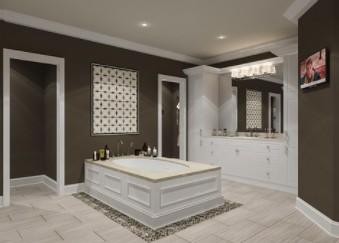Creating a budget for a bathroom renovation can be challenging. There’s a lot to consider. Compile a list of ‘must haves’ and ‘like to haves’ and work out a compromise between the two. Maybe a double vanity is non-negotiable, but you’re willing to forego the freestanding bath? Also, determine from the outset whether you can afford to design a whole new bathroom or if a retrofit would be more finance-friendly.
If you don’t have a builder or project manager overseeing your bathroom renovation. You need to be able to keep the project on track yourself. Taking on a bathroom design is a big task. So make sure you have a thorough understanding of the order of necessary tasks to help keep your tradespeople happy, and make sure everything arrives on time.
The usual sequence of events is; demolition, plumbing, waterproofing. Painting/tiling followed by installation of new fixtures and fittings. The sequence in which you select your bathroom products can have a domino effect. Which, if done incorrectly, can result in some big mistakes come installation day. There are many elements to consider when choosing your fixtures, fittings and tapware, so it’s important to proceed in the right order to avoid a disaster.
Choose products from largest to smallest. Your bath and vanity choices will then dictate tapware, basins and accessories. You need to factor in how the bathroom will be used before making these decisions. For example, you need to choose the correctly sized basin and mixer to ensure you don’t get splashed every time you use it.
Your bathroom is one of the most used rooms so choose quality fixtures that will go the distance.
When you reach the planning stage, think about all of the fixtures required in your bathroom. Right down to the size and location of your towel rails and toilet roll holder.
People forget to factor in what’s happening elsewhere in their home. When they’re choosing materials and finishes for their bathroom. But if you choose these items in isolation. Your bathroom can end up feeling visually disconnected from the rest of your home.
When selecting materials and finishes, make sure there is a common visual thread that ties them to ones used in the rest of your home. People tend to focus on how the tiles will look when they’re laid. And forget that grout can have a huge impact on the result. Using a grout that contrasts with the tile colour can accentuate an interesting layout pattern such as brick bond or herringbone. While a grout colour that matches your tiles will create a subtle, seamless look.
People often put too many patterns or features into their bathroom and they end up competing with each other. Richly patterned tiles can look stunning, but can be overwhelming if they’re not balanced out properly. As this bathroom has been.
Also, people often don’t factor in the scale of the room when choosing their tile format. The tile size you choose should be in proportion to the size of the bathroom.
Decide what the standout feature of the room will be. If you’ve chosen a patterned floor tile. I’d suggest balancing it out with a neutral or plain tile for the walls (plus, too much pattern will date quickly). Then take a close look at how all the elements you’ve chosen will look together – the vanity, tapware, floor tiles, benchtop material and joinery. And when selecting tile format, let the dimensions of the room dictate the size.

